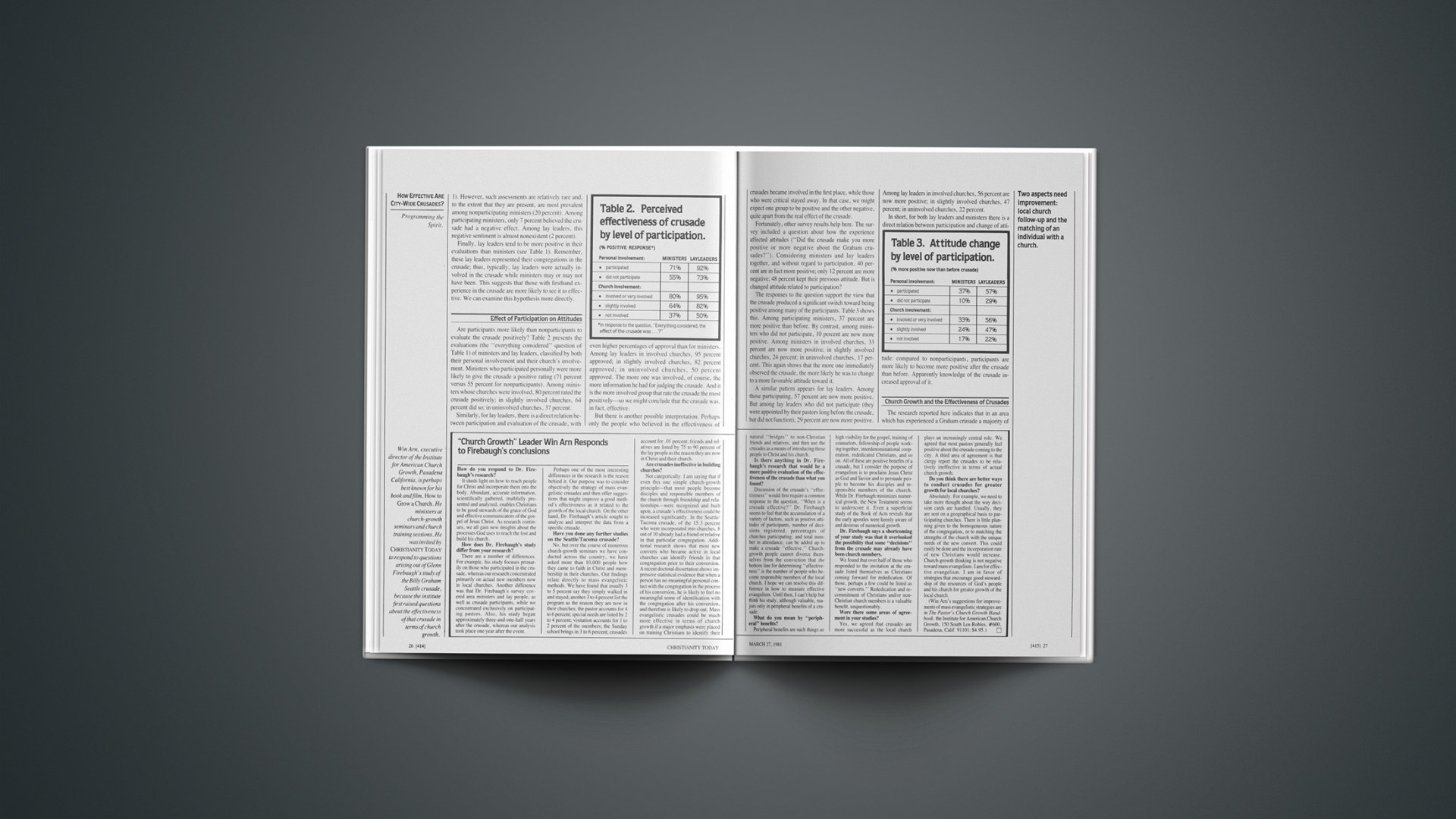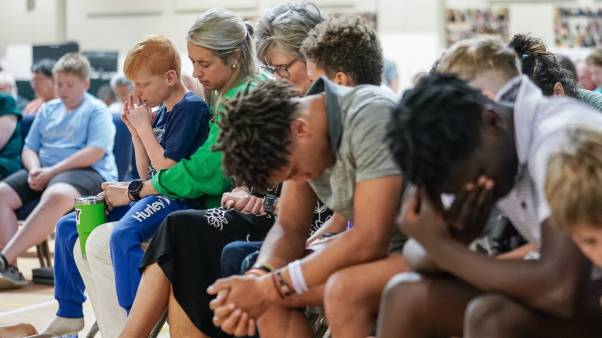How do you respond to Dr. Firebaugh’s research?
It sheds light on how to reach people for Christ and incorporate them into the body. Abundant, accurate information, scientifically gathered, truthfully presented and analyzed, enables Christians to be good stewards of the grace of God and effective communicators of the gospel of Jesus Christ. As research continues, we all gain new insights about the processes God uses to reach the lost and build his church.
How does Dr. Firebaugh’s study differ from your research?
There are a number of differences. For example, his study focuses primarily on those who participated in the crusade, whereas our research concentrated primarily on actual new members now in local churches. Another difference was that Dr. Firebaugh’s survey covered area ministers and lay people, as well as crusade participants, while we concentrated exclusively on participating pastors. Also, his study began approximately three-and-one-half years after the crusade, whereas our analysis took place one year after the event.
Perhaps one of the most interesting differences in the research is the reason behind it. Our purpose was to consider objectively the strategy of mass evangelistic crusades and then offer suggestions that might improve a good method’s effectiveness as it related to the growth of the local church. On the other hand, Dr. Firebaugh’s article sought to analyze and interpret the data from a specific crusade.
Have you done any further studies on the Seattle/Tacoma crusade?
No, but over the course of numerous church-growth seminars we have conducted across the country, we have asked more than 10,000 people how they came to faith in Christ and membership in their churches. Our findings relate directly to mass evangelistic methods. We have found that usually 3 to 5 percent say they simply walked in and stayed; another 3 to 4 percent list the program as the reason they are now in their churches; the pastor accounts for 4 to 6 percent; special needs are listed by 2 to 4 percent; visitation accounts for 1 to 2 percent of the members; the Sunday school brings in 3 to 6 percent; crusades account for .01 percent; friends and relatives are listed by 75 to 90 percent of the lay people as the reason they are now in Christ and their church.
Are crusades ineffective in building churches?
Not categorically. I am saying that if even this one simple church-growth principle—that most people become disciples and responsible members of the church through friendship and relationships—were recognized and built upon, a crusade’s effectiveness could be increased significantly. In the Seattle/Tacoma crusade, of the 15.3 percent who were incorporated into churches, 8 out of 10 already had a friend or relative in that particular congregation. Additional research shows that most new converts who became active in local churches can identify friends in that congregation prior to their conversion. A recent doctoral dissertation shows impressive statistical evidence that when a person has no meaningful personal contact with the congregation in the process of his conversion, he is likely to feel no meaningful sense of identification with the congregation after his conversion, and therefore is likely to drop out. Mass evangelistic crusades could be much more effective in terms of church growth if a major emphasis were placed on training Christians to identify their natural “bridges” to non-Christian friends and relatives, and then use the crusades as a means of introducing these people to Christ and his church.
Is there anything in Dr. Firebaugh’s research that would be a more positive evaluation of the effectiveness of the crusade than what you found?
Discussion of the crusade’s “effectiveness” would first require a common response to the question, “When is a crusade effective?” Dr. Firebaugh seems to feel that the accumulation of a variety of factors, such as positive attitudes of participants, number of decisions registered, percentages of churches participating, and total number in attendance, can be added up to make a crusade “effective.” Church-growth people cannot divorce themselves from the conviction that the bottom line for determining “effectiveness” is the number of people who become responsible members of the local church. I hope we can resolve this difference in how to measure effective evangelism. Until then, I can’t help but think his study, although valuable, majors only in peripheral benefits of a crusade.
What do you mean by “peripheral” benefits?
Peripheral benefits are such things as high visibility for the gospel, training of counselors, fellowship of people working together, interdenominational cooperation, rededicated Christians, and so on. All of these are positive benefits of a crusade, but I consider the purpose of evangelism is to proclaim Jesus Christ as God and Savior and to persuade people to become his disciples and responsible members of the church. While Dr. Firebaugh minimizes numerical growth, the New Testament seems to underscore it. Even a superficial study of the Book of Acts reveals that the early apostles were keenly aware of and desirous of numerical growth.
Dr. Firebaugh says a shortcoming of your study was that it overlooked the possibility that some “decisions” from the crusade may already have been church members.
We found that over half of those who responded to the invitation at the crusade listed themselves as Christians coming forward for rededication. Of those, perhaps a few could be listed as “new converts.” Rededication and recommitment of Christians and/or non-Christian church members is a valuable benefit, unquestionably.
Were there some areas of agreement in your studies?
Yes, we agreed that crusades are more successful as the local church plays an increasingly central role. We agreed that most pastors generally feel positive about the crusade coming to the city. A third area of agreement is that clergy report the crusades to be relatively ineffective in terms of actual church growth.
Do you think there are better ways to conduct crusades for greater growth for local churches?
Absolutely. For example, we need to take more thought about the way decision cards are handled. Usually, they are sent on a geographical basis to participating churches. There is little planning given to the homogeneous nature of the congregation, or to matching the strengths of the church with the unique needs of the new convert. This could easily be done and the incorporation rate of new Christians would increase. Church-growth thinking is not negative toward mass evangelism. I am for effective evangelism. I am in favor of strategies that encourage good stewardship of the resources of God’s people and his church for greater growth of the local church.
(Win Arn’s suggestions for improvements of mass evangelistic strategies are in The Pastor’s Church Growth Handbook, the Institute for American Church Growth, 150 South Los Robles, #600, Pasadena, Calif. 91101; $4.95.)










